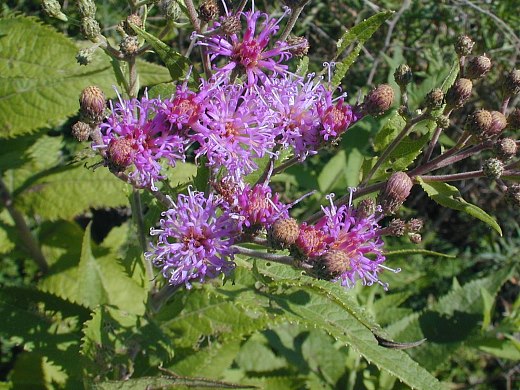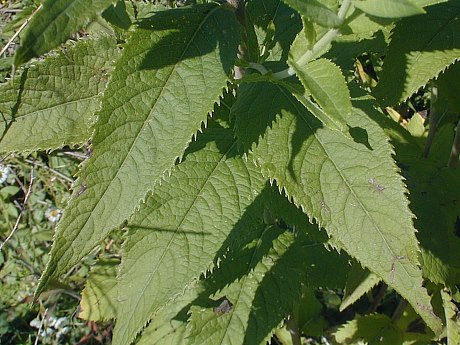Description: This perennial plant is 2½–5' tall and unbranched, except near the inflorescence at the apex. The stout central stem is covered with fine white hairs that are quite short. It may have some light purple coloration in some areas. The alternate leaves are up to 5" long and 2" across. They are lanceolate or lanceolate-ovate with serrated margins. Their green upper surface is rough-textured, while the lower surface is finely pubescent with some short white hairs on the major veins. The leaves are short-petioled or sessile against the stem. At the apex of the plant is a loose cluster of flowerheads that is more or less flattened on top. Each flowerhead has 15-30 magenta disk florets and no ray florets. At the base of the flowerhead, are numerous green bracts with recurved tips (i.e., they have a tendency to curl outward). A disk floret has 5 narrow lobes that spread outward, and a prominent divided style. The tips of the style often curl back to form a pair of small coils. The blooming period is mid- to late summer, and lasts about a month. There is no floral scent. The disk florets are replaced by bristly achenes that are flat and oblong. The root system is coarsely fibrous and produces rhizomes, which enable the vegetative spread of this plant.

Cultivation:
The
preference is full or partial sun and mesic to dry conditions. This
plant is not particular about soil type; it often grows in soil that
contains clay or abundant rocky material. This species of Ironweed is
more drought-resistant than other species in the genus. It blooms a
little earlier as well.
Range & Habitat:
The native Baldwin's Ironweed is an occasional plant in southwest
Illinois, and it is
rare or absent elsewhere (see Distribution
Map). This plant is more common in states that lie southwest
of
Illinois (e.g., Missouri). Habitats include upland areas of dry
prairies, hill prairies, glades, openings in upland forests, thinly
wooded rocky slopes, pastures, abandoned fields, areas along railroads,
and miscellaneous waste areas.

Faunal
Associations:
Primarily long-tongued bees, butterflies, and skippers visit the
flowers for nectar. Short-tongued bees may collect pollen from the
flowers, but they are non-pollinating. Among the bees, are such
visitors as bumblebees, Epeoline Cuckoo bees, and Miner bees. Among the
butterfly visitors, Swallowtail and Sulfur butterflies are particularly
prominent. The caterpillars of some moth species feed on various parts
of Ironweed, including Grammia parthenice
(Parthenice Tiger Moth), Perigea xanthioides (Red
Groundling), and Papaipema cerussata (Ironweed
Borer Moth). Mammalian herbivores generally avoid eating the foliage of
Ironweed spp. because of its bitter taste. In pastures, Ironweeds tend
to increase at the expense of other plants.
Photographic Location:
The photographs were taken of a small colony of plants growing in a
prairie at Meadowbrook Park in Urbana, Illinois, where this species was
undoubtedly introduced.

Comments: Baldwin's Ironweed is one of the less common species of Ironweed in Illinois. It is a sturdy plant that is well-adapted to dry prairies. The most distinctive characteristic of Baldwin's Ironweed is the recurved tips of its involucral bracts; this sets it apart from other Ironweed spp. in Illinois, which have appressed bracts. However, there is a less common variety of Baldwin's Ironweed that also has appressed bracts at the base of the flowerheads. Baldwin's Ironweed can be distinguished from Vernonia missurica (Missouri Ironweed) by counting the number of disk florets in a flowerhead – Baldwin's Ironweed has 15-30 disk florets, while Missouri Ironweed has 30-55 disk florets. With respect to Vernonia gigantea (Tall Ironweed), Baldwin's Ironweed is a stouter plant with broader leaves. Finally, the stems and leaf undersides of Baldwin's Ironweed are pubescent, while Vernonia fasciculata (Smooth Ironweed) is glabrous throughout. Sometimes, different species of Ironweed hybridize with each other, making identification difficult. Another common name for Vernonia baldwinii is Western Ironweed.